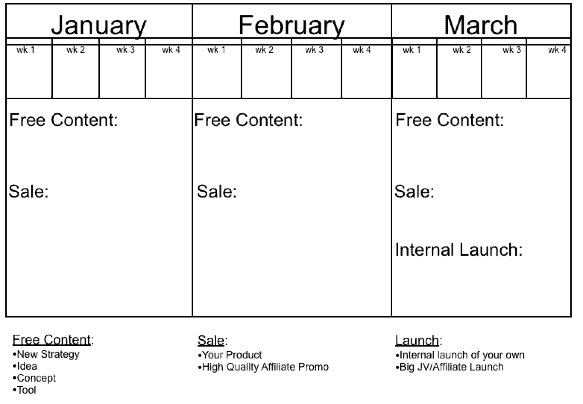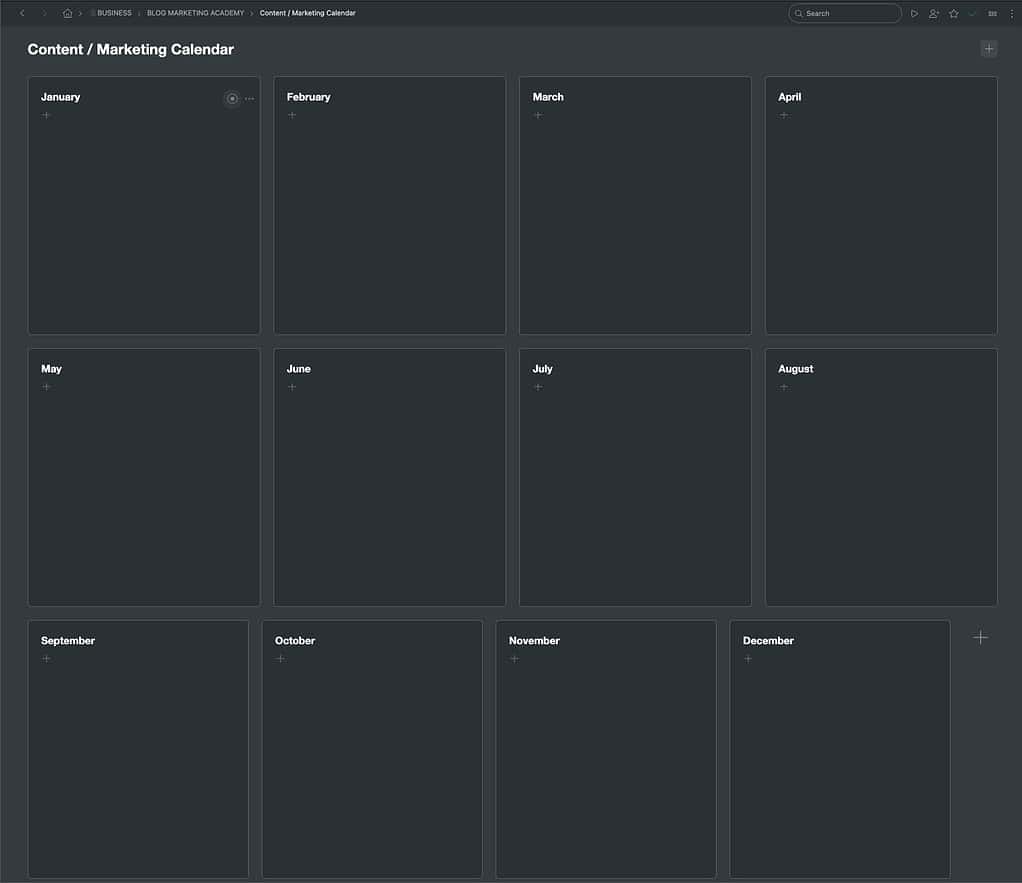In This Post…
I have been blogging for a long time now and during that time, I’ve had many different styles of content planning.
I’ve tried the “no planning” approach, where I’ve sat down knowing I needed to write something but had no idea what the hell to write. Been there, done that. 🙂
I’ve done the “mini planning” approach, where I plan out the blog for the next week. Or, if I’m feeling particularly ambitious, maybe two weeks at a time. For many blogs, this approach is preferable. Obviously, for news-style sites, it would be practically impossible.
And, a little more recently, I’ve tried planning out my content for an entire quarter at once.
It is this last option which I want to talk to you about today. And, I want to share with you the exact process and system I use to plan out content for that far in advance.
Let’s Start With A Back-Story
Let’s rewind the clock a few years. Back when I was more closely following the world of classic internet marketing.
I would watch various “gurus” prep for launches. I was on their JV list (joint venture) so I would many times know in advance that the launch was coming. And, many times, they would give exact dates for their pre-launch and launch, with the request that I “put it on your calendar”.
This phrase – “put it on your calendar” – obviously assumed that I was USING a calendar. Of course, I wasn’t. 🙂 Well, I was using one for appointments and the like, but not my emails and content.
In other instances, I was exposed to some of the materials of some of the big names in marketing. Guys like Jeff Walker or Brendon Burchard. I mention these two particular guys because I remember material from them which talked about planning content far in advance. Jeff is known for meticulous planning – especially for a launch. Jeff rarely puts out content without some kind of reason for it.
And, Brendon one time talked about content planning for an entire YEAR. In fact, as I seem to recall, he had a timeline where he did a launch every quarter. And, each quarter was pre-planned so that the free content which was released was essentially a lead-up to the launch which would be coming at the end of the quarter. He would also do some kind of sale each month, with content geared around that as well.

So, the notion I was left with was that many who were running successful content-based businesses online were planning things far in advance and being quite strategic about it. Whereas most of the traditional bloggers who weren’t making much money at all were flying by the seat of their pants, relatively speaking.
The Importance Of Content Planning
First of all, let’s get one concept crystal clear…
The very notion of being strategic with your content means you must PLAN. If you’re not operating by a plan, then it isn’t strategic. Don’t just believe it… go look it up in the dictionary if you want. 🙂
So, content planning is very important. This is the exact opposite of what many bloggers end up doing, which is flying by the seat of their pants. Most bloggers don’t know what their next blog post is going to be.
Now, the next step is HOW to plan out the content.
You could simply sit down and write out a bunch of blog post ideas. Assign them to your calendar and – boom! – you’ve got yourself an editorial calendar. And, hey, that’s better than nothing. I guess. 😉
But, that isn’t strategic.
Being strategic about your blog content means that each piece of content you release has a reason to exist.
Each video, each blog post – all of it – is placed there for a specific reason. The reason could be:
- To directly promote something.
- To act as a lead magnet into an offer (SEO bait)
- To act as a piece of pre-launch content
- To further along a story (but a story which has a pre-planned ending and release of built-up tension)
And there are others. The point is, each piece of content is a piece of pre-planned MARKETING.
This site isn’t called the BLOG MARKETING ACADEMY for nothing. 😉
The prerequisite of this is, of course, having things to market. Things to sell. That’s a topic we’ve discussed on this site before – and will again. But, for today, I’m going to assume you’ve got that taken care of. This is a post about content planning.
So, let’s get on with it…
The Content Planning Process Overview
When you’re on a boat, one of the more annoying things you can do is hit the bottom. It is called running aground. The way you avoid doing that in areas of shallow water is to stay in between the channel markers. Those are big pilings which stick up out of the water, marking the pathways (channels) which are deep enough for your boat. You know where you want to go, but you do it by way of the channels.

When it comes to our content planning, the “channel markers” are going to be pre-determined campaigns and dates which you pre-set. Those things mark the channels which guide you. So, for that reason, we start off by coming up with those dates.
So, here’s a general breakdown:
- List any campaigns or launches you intend to do.
- List any general ideas you want to pursue in the next period (i.e. “I want to do more webinars”, or “I really need to work on ______”.)
- Look at the calendar and see if there are any holidays or events coming up around which you may run a promotion or other campaign.
- Get out your call to action map.
- Starting with your major campaigns or events as your focus points, begin mapping content releases around those dates.
- If there are any “gaps”, fill them in with content pieces which foster the audience relationship, gather market information, or will serve as a long-range content asset.
Alright, so let’s go through this one by one…
#1 – List any campaigns or launches you intend to do.
When you’re running a business, you have to make offers. If you don’t actively market and sell things, you’ll go broke or you won’t ever have a business to run in the first place. So, with that said…
Decide what promotions or launches you want to run. Then, assign dates to them.
In my case, let’s say I decided I want to run a membership special offer for a week in October. I would sit down in advance and decide which week it is going to be. I would list the dates. And, I would repeat that process for any other promotion or general campaign I intend to run.
This simple exercise can already be eye-opening for many people, because you’re actually being forced to orchestrate structured promotions for things – even if they’re affiliate products. And, guess what – that’s how you make money. 🙂
#2 – List any general ideas you want to pursue for the next period.
We all have goals, or things we need to improve upon.
It could be that you want to make more videos, in general. It could be podcasting. It could be that you’re in the middle of a content audit and want to build major content updates into your overall plan.
Whatever it is for you, write it down and you want to take this into account in your content planning.
#3 – Look at the calendar and see if there any any holidays or events coming up around which you may want to run a promo.
So, a Thanksgiving special? Black Friday? A Christmas promo? A “New Years” sale?
You get the idea. 🙂
But, it isn’t just holidays – and it isn’t just about sales.
First, your niche may have various events which are important. A big conference, maybe? Perhaps you, in your own personal life, have some important dates coming up which you could time something around. Perhaps a birthday?
But, while offers are what drive a business, offers don’t have to be the only reason you can time things around holidays or events. Perhaps you could use a holiday as a theme for a piece of content.
#4 – Get out your call to action list.
For the purposes of this post, a call to action list is a simple tool for tracking all of your potential calls to action, whether they be opt-in offers, things to buy, or simply social media tweet buttons. I find that it is handy to keep all your CTAs in one central place for reference. Perhaps a spreadsheet or a mind map.
#5 – Starting with your major campaigns or events as your focus points, begin mapping content releases around those dates.
Now, you should have a list of dates or date ranges for various campaigns you can run. With those serving as your “channel markers”, you now map out public release content around those dates.
This is the point where good content marketing practices come into play. It would be obvious to have a post which simply announces a product or a sale. That’s obvious.
But, any good marketing campaign does a lot more than just say “Here’s something you can buy.” From a blog marketing perspective, there is more work done during the LEAD UP to the campaign.
You can tell a story, for instance. That story will conclude with a lead-in to your offer.
You can also take the classic AIDA sales formula (Attention, Interest, Desire, Action) and build a content campaign around that. Post #1 serves as a “shot across the bow”, designed to peak their interest and get their attention. Post #2 is designed to raise their interest and really build up tension. Post #3 intensifies desire. And at the end, you lead right into Action – which would be the “buy now” button.
This whole thing might run for a week or two BEFORE the actual dates of your marketing event. So, for instance, you could have two weeks of content following the AIDA formula, then a week of content which invites them to take action. Total of 3 weeks worth of content around one marketing campaign.
You get the idea? 🙂
#6 – Fill in the gaps.
Now, there can definitely be gaps on the timeline. Time in between where you don’t have some kind of marketing campaign going on, but where you don’t want a big black hole of no content releases.
Besides, you DON’T want everything you ever release to be a gear-up to a sale. That’d be ridiculous.
So, these gaps are still things you plan for. You don’t want to just fly by the seat of your pants from marketing campaign to marketing campaign.
The thing with gap content is that you want to be STRATEGIC. As mentioned above, some purposes for existence might include:
- To enhance your relationship with your audience (perhaps by telling a deeper story)
- To gather market intelligence which would be helpful later (i.e. surveys and polls)
- Viral bait (posts designed to have as much viral potential as possible for audience and traffic building)
… and there are others. But, the point is, you want to have a REASON FOR EXISTENCE for each post. Know what your PURPOSE is to it.
For instance, I’m writing this very post for two reasons:
- To provide you with something really valuable, to help my audience and hopefully attract new readers.
- To hopefully provide so much value that you – the reader – will feel I have earned a retweet or share to your social media accounts.
That’s WHY I’m doing this post. And, while I am going to give you a call to action at the end, this very post would be gap content for me. It isn’t part of a larger marketing campaign.
How To Track And Manage Your Editorial Calendar
There are numerous tools and methods for building and managing a content editorial calendar. Everybody seems to have their own preferences and their own work style.
I used to use a big, complicated spreadsheet with all these fancy columns with dates, titles, SEO terms, deadlines, etc. But, frankly, I stopped using that a long time ago. It felt like I was trying to make this process complex when it really isn’t.
I like to keep things simple.
For date tracking, using your calendar is the easiest. Whichever calendar you use the most, just use that. For me personally, I tend to use Apple Calendar these days and that gets mirrored into FastMail. I have a calendar in the system called “Content” and I have it highlighted in a bright color. Then, any of my scheduled time spent on content creation as well as future content releases get assigned to that calendar.
Then, for a looser structure that I can customize, I am personally a fan of outlining tools like Dynalist and Workflowy. These days, I find that I prefer Workflowy and one of the main reasons for that is the different layout styles you can use to show your outline.
Below, here’s a simple monthly grid layout in WorkFlowy which uses the “Dashboard” layout.

It is easy, then, to drop content items into any of these months and drag them around. And, of course, since it is an outlining tool, you can drill down into each item as deep as you want, outline the content itself, assign specific calendar dates to them, etc.
WorkFlowy is a powerful tool. Useful for many things. But, personally, I prefer this kind of tool because I can customize it as I see fit. Spreadsheets aren’t as easy to use. Calendars are too rigid.
The tools we use for this need to be usable by US… otherwise we’re not likely to utilize them. It needs to be easy.
The important thing here is that you go through the process (see above), spend the time planning out your content calendar with some actual intention, and then use whatever tools you work naturally with to arrange and manage it.
Got A Question? Need Some Assistance?
Have a question about this article? Need some help with this topic (or anything else)? Send it in and I’ll get back to you personally. If you’re OK with it, I might even use it as the basis of future content so I can make this site most useful.



